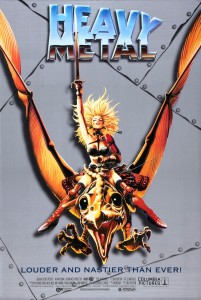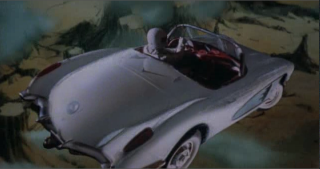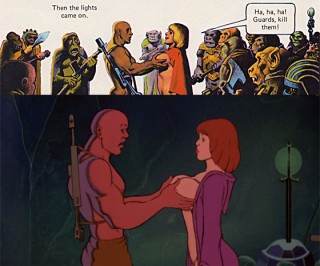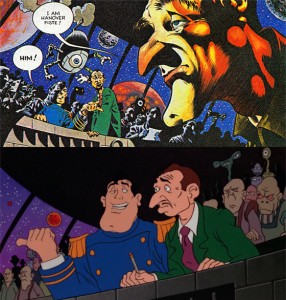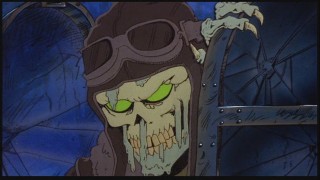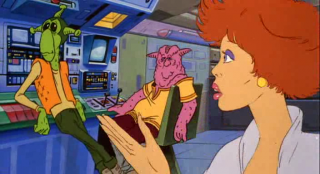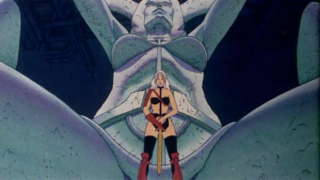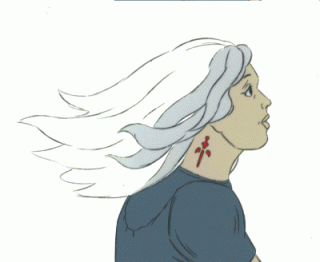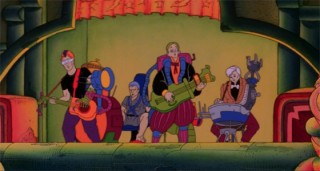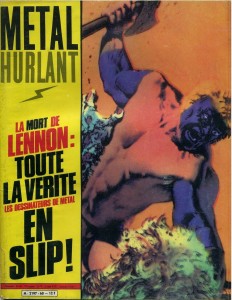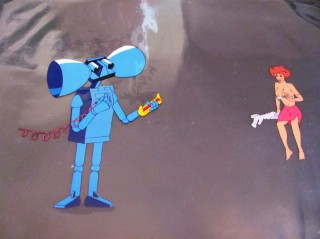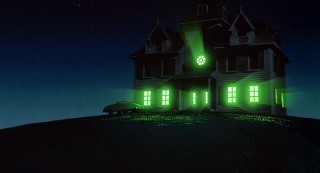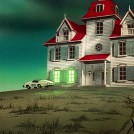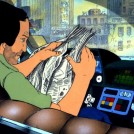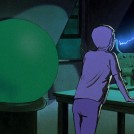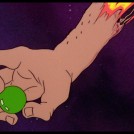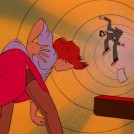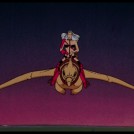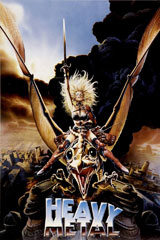
Heavy Metal was released on Aug. 7, 1981. It was produced on a meager $9.3 million budget, but grossed nearly $20 million dollars during it’s initial theatrical release. Twenty-five years later, after some music industry scuffles about song rights, the film was re-released, as “Louder and Nastier than Ever,” in theaters on March 8, 1996 and later that year was released on VHS and Laserdisc, which sold over a million units. Fifteen years after that in 2011, it was released on Blu-ray.
The film follows closely to the magazine it shares its title with, in that it was a film made up of 10 stories, although only nine were released. The only differentiating factor between the movie and the magazine, is that the movie is tied together with the Loc-Nar, while the magazine stories are not tied together at all in any given issue.
Also staying true to its magazine roots was the inclusion of animated violence and gore, nudity, explicit language, and comedy. Although the movie has a little more comedy influence due to director Ivan Reitman and his cast of voice over characters, Heavy Metal is very much the epitome of Sword and Sorcery meets science fiction meets Playboy.
The film is a combination of straight up old school animation with some rotoscoping mixed in. Due to the nature of the film, many animators jumped at the chance to be a part of the process. This is similar to the reaction that Ralph Bakshi, the king of rotoscoping, received when he put out calls for animating his adult cartoons.
In fact, at this time Bakshi was the only animation director making cartoons for adults. Heavy Metal, when it was finished, would join the ranks of his films – Fritz the Cat, Heavy Traffic, Coonskin and Wizards. This may be the reason that Ralph Bakshi and his movies are heavily related to Heavy Metal, and in some instances he is even falsely identified as the director.
The original 10 stories or vignettes are Soft Landing, Grimaldi, Harry Canyon, Den, Captain Sternn, Neverwhere Land , B-17, So Beautiful and So Dangerous, Taarna, and Epilogue.
The films title sequence, shows the universe, with a glowing green orb, with the narrative of “a shadow shall fall over the universe, and evil will grow in its path, and death will come from the skies.”
Soft Landing is just after the film’s title sequence, which includes a white 1960 Corvette, being ejected from a space shuttle orbiting Earth and descending through the atmosphere on it’s journey back home. The Corvette was completely rotoscoped and the descent is accompanied by “Radar Rider” by Riggs. This could very well be the perfect set up for this film. The scene ends as the Corvette pulls up to a house.
Grimaldi is the continuation of Soft Landing, where Grimaldi, the pilot of the Corvette gets out of the Corvette and goes into the house to give his daughter a gift; a glowing green space rock. The rock is the Loc-Nar, a plot device created by the film producers to tie the vignettes together. The Loc-Nar kills Grimaldi and then announces to Grimaldi’s daughter “do not try to escape, you are in my control. Look at me, I am the sum of all evils. Look carefully, my power infests all times, all galaxies, all dimensions. But many still seek me out; a green jewel they must possess. But see how I destroy their lives.”
This leads us to Harry Canyon, where we see the Loc-Nar being dug up to the sounds of Blue Öyster Cult’s “Veteran of the Psychic Wars”. Then we meet Harry Canyon himself, who drives a cab in New York City. Harry rescues a girl from gangsters who killed her father and are trying to get their hands on the Loc-Nar. All in all, this story has a little romance, sex, gore-filled death scenes, and humor.
But watch closely and you’ll see elements of this particular vignette that you’ve seen in other movies, such as Blade Runner for example. In addition, one movie seems to have taken Harry Canyon and worked in a different angle and complete story all together – The Fifth Element. There is no denying the influence this vignette had on that film. In fact, I would wager without Harry Canyon there is no Corben Dallas.
Den is almost a carbon copy of what Richard Corben created, except with more humor. That’s because the character of Den was voiced by the legendary John Candy. In fact, John Candy would take a break from the production of Stripes to do the voice over for Den. Although the Loc-Nar didn’t exist in the Den comics, it was well-threaded into the story and didn’t take away from the original material. The animation also stayed true to Corben’s original style of the characters.
Captain Sternn, like Den, also stayed true to the original characters and story from Heavy Metal magazine. Again, the Loc-Nar was added into the original material. From here, the movie takes us to the B-17 story, but the original cut had a scene, Neverwhere Land, in between that tied Captain Sternn and B-17 together.
Neverwhere Land was a truly beautiful piece of animation that showed Hanover Fists’s hand still clinging to the Loc-Nar land on an uninhabited planet. We then see the evolution of the planet and the influence of the cursed rock on its changes. This then goes through to a world war, which is where B-17 comes in as a natural progression. The scene was cut from the theatrical release, but it can be seen on the DVD and Blu-ray as a deleted scene. In hindsight, watching the scene, it’s apparent that they had to cut it as it made the movie run too long, but it could very well have been the best scene in the movie.
B-17 has minimal dialogue and is about the Loc-Nar turning some soldiers flying on a B-17 into zombies. The original story this was based off of didn’t have the Loc-Nar. Instead, it had little gremlins, but the switch works very well.
So Beautiful and So Dangerous is unique in the film as, even though it takes place in one location, it follows two stories with one assuming a more Cheech and Chong approach than the other. The story starts with the abduction of two humans in Washington, D.C. Although Dr. Anrak is destroyed, Gloria the stenographer survives. Gloria, who is wearing the Loc-Nar as a broach, gets hit on by a robot and the two have a small romance. Meanwhile, the two aliens get high on plutonian nyborg.
There are some great things that come from each story. First is the robot talking to Gloria about marriage and the guilt of robotic sexual pleasure. A few quotes come to mind: “Earth women who experience sexual ecstasy with mechanical assistance always tend to feel guilty!” “I’m just scared I’ll come home one day and find you screwing a toaster,” Gloria quips, to which he replies, “You’ll just have to trust me.” But let’s not forget our Cheech and Chong pilots who have been getting high on nyborg. While getting ready to land, one says to the other, “Look, man, if there’s one thing I know, it’s how to drive while I’m stoned. It’s like you know your perspective’s fucked so you just let your hands work the controls as if you were straight.”
So Beautiful and So Dangerous is probably the funniest story in the film. Also, as a side note, during their high, the two aliens see the USS Enterprise during their drug-induced trip.
From there, the last full story is Taarna, an epic western-like story based loosely on Harzakc by Moebius. A group of men of science and learning are being attacked by mutated barbarians and they call on the race of Taarak the Defender to aid them. Although the men are killed, Taarna is summoned. “To defend: this is the pact. But when life loses its meaning and is taken for naught, then the pact is to avenge!”
Taarna’s preparations for battle are as epic a scene like this could be. It is a beautiful woman naked and getting dressed, but it’s slow and methodical and the whole scene has a realistic feel, because it was rotoscoped with model Carole Desbiens.
Taarna doesn’t speak, but she doesn’t need to. She has one job and she does it, by finding the barbarians and killing their leader. Then, she flies above a volcano, sacrificing herself to destroy the Loc-Nar within the volcano.
This leads us to the Epilogue, where we see the house destroyed and the girl escaping. It is then that we see Taarna’s mount reborn and we learn that Taarna’s soul has been transferred to hers. “And the spirit of time is transferred, across the universe, to a new defender and the power of evil is contained for another generation and a new Taarakian is born to protect the next.”
The house explosion was originally going to be rotoscoped, but the movie, originally scheduled to be out in October or November of 1981, was moved up to August and the scene had to be completed with the exploding model.
The animation, the rotoscoping, the art in all forms in this movie are great, but the music must be talked about as well.
Although the stories are only held together through the Loc-Nar, the music makes this movie feel more like a rock opera. The film’s released soundtrack is as follows:
- “Heavy Metal” by Sammy Hagar
- “Heartbeat” by Riggs
- “Working in the Coal Mine” by Devo
- “Veteran of the Psychic Wars” by Blue Öyster Cult
- “Reach Out” by Cheap Trick
- “Heavy Metal (Takin’ a Ride)” by Don Felder
- “True Companion” by Donald Fagen
- “Crazy (A Suitable Case for Treatment)” by Nazareth
- “Radar Rider” by Riggs
- “Open Arms” by Journey
- “Queen Bee” by Grand Funk Railroad
- “I Must Be Dreamin'” by Cheap Trick
- “The Mob Rules” by Black Sabbath
- “All of You” by Don Felder
- “Prefabricated” by Trust
- “Blue Lamp” by Stevie Nicks
And though it was used in the film, “Through Being Cool” by Devo and “E5150” by Black Sabbath weren’t on the released soundtrack. These 18 songs are enough to make the film part of what it is, but the completed piece also included a film score by Elmer Bernstein. In an unlikely move, both were released alongside the film in 1981. The music – both the songs and the score – fill the movie with more emotion that either could alone. This is part of what makes Heavy Metal the cult phenomenon that it is.
The film came to fruition because of National Lampoon, known then for its own magazine of the same name and for the 1978 classic Animal House. National Lampoon licensed Metal Hurlant, a French science-fantasy magazine to create the Heavy Metal magazine that we know and love in America.
Many of the original stories published in Metal Hurlant were translated and reprinted in Heavy Metal. This is how Heavy Metal came to the silver screen, because National Lampoon saw the success of the Heavy Metal magazine and gave Ivan Reitman, the producer of Animal House, the go-ahead to make the film.
Reitman had never done any animation at this point in his career and there wasn’t a huge animation studio behind the project, so each segment had its own director and basically all of those segments were done by different little independent animation studios across the globe in Canada, England, France and the United States. Reitman’s connections to the Second City talent of John Candy, Joe Flaherty, Eugene Levy, Harold Ramis, and his use of John Vernon from Animal House made this movie what it is, from a strictly voice talent perspective.
Just as it was for animators who worked on the adult feature animations of Ralph Bakshi, it was a dream for the animators to work on Heavy Metal. Like most animators of that time, it was all about creating entertainment for children, but when given the chance to work on creating something for themselves, it was much like a dream come true. As I have said before the animators closely followed the style of the original stories, when using a story that was borrowed and not created for the film. Adapting styles cannot be the easiest thing to do, but they did it and the movie is all the more beautiful because of the blending of so many different styles.
This is a film that cannot be made again. It was made at the right time and right place in both cinematic history and cultural history. It was released in 1981 and it reflects what the future might have been and the non-political correctness and morals of the time. An epitaph, if you will, of the counter culture revolution as one last chance to revel in sex and gore.
The movie as a whole has a slightly psychedelic feeling both because of the different styles used to create it and because you don’t know what style or story is coming next. There is a wish fulfillment theme throughout that we as the audience can decide which story or stories fulfills our wishes. This film was made for guys and was made by guys. This explains the large breasted women, both clothed and otherwise, but again, it was based off of Heavy Metal, which was also for the guys.
Heavy Metal, the film, is a cult phenomena, bringing together different styles of art, different tastes in music, a wonderful score and the Loc-Nar, the source of all evil to bring it together. This is a film that, even decades on, is still relevant to the counter-culture and even popular culture. It is lightning in a bottle and something we’re not likely to see every again. In a word, Heavy Metal is brilliant.
Read the Secret File of technical information and quotes from Heavy Metal.
